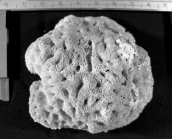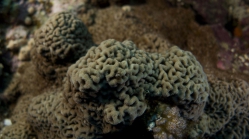
| About | | Search taxa | | Taxon tree | | Search literature | | Checklist | | Stats | | Log in |
WoRMS taxon detailsCoscinaraea monile (Forskål, 1775)
207255 (urn:lsid:marinespecies.org:taxname:207255)
accepted
Species
Astraea maeandrina Ehrenberg, 1834 · unaccepted > junior subjective synonym
Astraea meandrina Ehrenberg, 1834 · unaccepted > junior subjective synonym
Coscinaraea bottae Milne Edwards & Haime, 1848 · unaccepted > junior subjective synonym
Coscinaraea donnani Gardiner, 1905 · unaccepted > junior subjective synonym
Coscinaraea maeandrina (Ehrenberg, 1834) · unaccepted > junior subjective synonym
Coscinaraea meandrina (Ehrenberg, 1834) · unaccepted > junior subjective synonym
Coscinaraea ostreoeformis van der Horst, 1922 · unaccepted > junior subjective synonym
Coscinarea donnani (Gardiner, 1905) · unaccepted > junior subjective synonym
Coscinarea maeandrina (Ehrenberg, 1834) · unaccepted > junior subjective synonym (misspelling)
Coscinarea ostreaeformis (van der Horst, 1922) · unaccepted > misspelling - incorrect subsequent spelling
Coscinastrea monile (Forskål, 1775) · unaccepted > superseded combination
Madrepora maeandrina (Ehrenberg, 1834) · unaccepted > junior subjective synonym
Madrepora monile Forskål, 1775 · unaccepted > superseded combination (basionym)
marine,
(of Madrepora monile Forskål, 1775) Forskål P. (1775). Descriptiones Animalium, Avium, Amphibiorum, Piscium, Insectorum, Vermium; quae in Itinere Orientali Observavit Petrus Forskål. Post Mortem Auctoris editit Carsten Niebuhr. Adjuncta est materia Medica Kahirina. Mölleri, Hafniae, 19 + xxxiv + 164 pp. , available online at https://www.biodiversitylibrary.org/page/2088059 [details]
Holotype (of Madrepora monile Forskål, 1775)
Holotype (of Madrepora monile Forskål, 1775) [details]
Description Colonies range from thick, foliaceous or encrusting coralla, to low, submassive forms, rarely larger than 20 cm diameter....
Description Colonies range from thick, foliaceous or encrusting coralla, to low, submassive forms, rarely larger than 20 cm diameter. This is a very polymorphic species, showing wide, habitat-related skeletal variations. Budding is intratentacular. Calices range from 3 to 7 mm across, and may be largely monocentric or may run in short meandroid series. Calice depth ranges equally greatly, from 2 to 5 mm. Walls are thick. Septa are thick, with granular edges; colonies from very turbid locations may be particularly granular, almost furry in appearance, with smaller calices. This is a very common species. It is particularly common on deeper parts of reef slopes where it can be found to at least 50 m deep. It is also common in turbid water of back reef slopes where it takes on a more contorted shape, and it is one of the few species commonly found in holes on reef flats and in close proximity to mangroves, and even is abundant in the areas of cold upwelling water (Sheppard, 1998). Often forms circular, encrusting, slightly mounded, plate-like colonies. The calices (3-7 mm) are variable in form, being circular to oval or long and meandering, and may be aligned in shallow, concentric valleys which are roughly parallel to the margin of the colony. Between the corallites, fine septo-costal connections overly this pattern. Colour: usually pale brown or greenish. Habitat: diverse, on reef flats to deeper slopes (Richmond, 1997). Tropical Indo-Pacific in Kalk (1958). [details]
Hoeksema, B. W.; Cairns, S. (2024). World List of Scleractinia. Coscinaraea monile (Forskål, 1775). Accessed through: World Register of Marine Species at: https://www.marinespecies.org/aphia.php?p=taxdetails&id=207255 on 2024-09-19
Date action by 2000-09-13 07:19:12Z changed Garcia, Maria
original description
(of Coscinaraea ostreoeformis van der Horst, 1922) van der Horst, C.J. (1922). Madreporaria: Agariciidae. Report of the Percy Sladen Trust Expedition to the Indian Ocean 1905, Volume 7. <em>Transactions of the Linnean Society of London, Series 2, Zoology.</em> 18 (1): 417-429, pls. 31-32. [details]
original description (of Coscinaraea donnani Gardiner, 1905) Gardiner JS. (1905). Madreporaria III. Fungida IV. Turbinolidae. <em>Fauna and geography of the Maldives and Laccadives Archipelagoes, Cambridge.</em> 2: 933-957, pls. 89-93. [details] original description (of Coscinaraea bottae Milne Edwards & Haime, 1848) Milne Edwards, H.; Haime, J. (1848). Note sur la classification de la deuxième tribu de la famille des Astréides. <em>Comptes rendus hebdomadaires des séances de l'Académie des sciences, Paris.</em> 27: 490–497., available online at https://doi.org/10.5962/bhl.part.29692 [details] original description (of Madrepora monile Forskål, 1775) Forskål P. (1775). Descriptiones Animalium, Avium, Amphibiorum, Piscium, Insectorum, Vermium; quae in Itinere Orientali Observavit Petrus Forskål. Post Mortem Auctoris editit Carsten Niebuhr. Adjuncta est materia Medica Kahirina. Mölleri, Hafniae, 19 + xxxiv + 164 pp. , available online at https://www.biodiversitylibrary.org/page/2088059 [details] original description (of Astraea maeandrina Ehrenberg, 1834) Ehrenberg, C. G. (1834). Beiträge zur physiologischen Kenntniss der Corallenthiere im allgemeinen, und besonders des rothen Meeres, nebst einem Versuche zur physiologischen Systematik derselben. <em>Abhandlungen der Königlichen Akademie der Wissenschaften, Berlin.</em> 1: 225-380., available online at https://www.biodiversitylibrary.org/page/29725862 [details] context source (HKRMS) ERM. (2003). The Proposed Submarine Gas Pipelines from Cheng Tou Jiao Liquefied Natural Gas Receiving Terminal, Shenzhen to Tai Po Gas Production Plant, Hong Kong. EIA report. Submitted to The Hong Kong and China Gas Company Limited. [details] context source (Hexacorallia) Fautin, Daphne G. (2013). Hexacorallians of the World. (look up in IMIS) [details] basis of record Lemmens, J. W. T. J. (1993). Reef-building corals (Cnidaria: Scleractinia) from the Watamu Marine National Reserve, Kenya; an annotated species list. <em>Zoologische mededelingen.</em> 67: 453-465. [details] additional source Sheppard CRC. (1987). Coral species of the Indian Ocean and adjacent seas: a synonymised compilation and some regional distribution patterns. <em>Atoll Research Bulletin.</em> 307: 1-32., available online at http:// https://doi.org/10.5479/si.00775630.307.1 [details] additional source Hoffmeister, J.E. (1925). Some corals from America Samoa and the Fiji Islands. <em>Papers from the Department of Marine Biology of the Carnegie Institution of Washington.</em> 22: 1-90, pls. 1-23. page(s): 43, 44 [details] additional source Cairns, S.D., B.W. Hoeksema & J. van der Land. (1999). Appendix: List of extant stony corals. <em>Atoll Research Bulletin.</em> 459: 13-46. page(s): 39 [details] additional source Cairns, S.D., B.W. Hoeksema & J. van der Land. (2007). as a contribution to UNESCO-IOC Register of Marine Organisms. (look up in IMIS) [details] additional source Benzoni, F., Stefani, F., Pichon, M., Galli, P. 2010. The name game: morpho-molecular species boundaries in the genus Psammocora (Cnidaria, Scleractinia). Zoological Journal of the Linnean Society 160: 421-456. page(s): 429, 434, 436, 437 [details] additional source Veron JEN. (2000). Corals of the World. Vol. 1–3. <em>Australian Institute of Marine Science and CRR, Queensland, Australia.</em> [details] additional source Gardiner JS. (1905). Madreporaria III. Fungida IV. Turbinolidae. <em>Fauna and geography of the Maldives and Laccadives Archipelagoes, Cambridge.</em> 2: 933-957, pls. 89-93. page(s): 950 [details] additional source Yabe H, Sugiyama T. (1935). Revised list of the reef-corals from the Japanese seas and of the fossil reef corals of the raised reefs and the Ryukyu limestone of Japan. <em>Journal of the Geological Society of Japan.</em> 42: 379-403. page(s): 397 [details] additional source Pillai CSG, Scheer G (1976) Report on the stony corals from the Maldive Archipelago. Results of the Xarifa Expedition 1957/58. Zoologica, Stuttgart 43 (126): 1-83, pls. 1-32. [details] additional source Pichon, M.; Benzoni, F. (2007). Taxonomic re-appraisal of zooxanthellate Scleractinian Corals in the Maldive Archipelago. <em>Zootaxa.</em> 1441: 21–33. page(s): 29 [details] additional source Matthai G (1924) Report on the madreporarian corals in the collection of the Indian Museum, Calcutta. Memoirs of the Indian Museum 8: 1-59. [details] additional source Gravier C. (1911). Les récifs de coraux et les Madréporaires de la baie de Tadjourah (Golfe d'Aden). <em>Annales de l'Institut Océanographique de Monaco.</em> 2 (3): 1-101, pls 1-12. [details] additional source Pillai CSG. (1972). Stony corals of the seas around India. <em>Proceedings of the First International Symposium on Corals and Coral Reefs, 1969. Marine Biological Association of India Symposium.</em> 5: 191-216. page(s): 202 [details] additional source van der Horst, C.J. (1922). Madreporaria: Agariciidae. Report of the Percy Sladen Trust Expedition to the Indian Ocean 1905, Volume 7. <em>Transactions of the Linnean Society of London, Series 2, Zoology.</em> 18 (1): 417-429, pls. 31-32. page(s): 423, 424 [details] additional source Boshoff, P.H. (1981). An annotated checklist of Southern Africa Scleractinia. <em>Oceanographic Research Institute Investigational Report, Durban.</em> 49: 1-45. page(s): 23 [details] additional source Veron, J. E. N. (2000). Corals of the World, Volume II: Families Astrocoeniidae, Pocilloporidae, Euphyllidae, Oculinidae, Meandrinidae, Siderastreidae, Agariciidae, Fungiidae, Rhizangiidae, Pectiniidae, Merulinidae, Dendrophylliidae, Caryophylliidae. Australian Institute of Marine Science. Townsville., volume 2, pp. 429. page(s): 158-159 [details] additional source Ortmann, A. (1892). Die Korallriffe von Dar-es-Salaam und Umgegend. <em>Zoologische Jahrbücher Abteilung für Systematik.</em> 6: 631-670., available online at https://biodiversitylibrary.org/page/10195227 page(s): 635, 651, [details] additional source Reed, J. K. (1985). Deepest distribution of Atlantic hermatypic corals discovered in the Bahamas. Proceedings of the Fifth International Coral Reef Congress, 6, 249-254 page(s): 253 [details] additional source Pillai CSG. (1983). Structure and generic diversity of recent Scleractinia of India. <em>Journal of the Marine Biological Association of India.</em> 25, 1-2, 78-90. page(s): 85 [details] additional source Kühlmann, D. H. H. (2006). Die Steinkorallensammlung im Naturhistorischen Museum in Rudolstadt (Thüringen) nebst ökologischen Bemerkungen. Rudolstädter Naturhistorische Schriften, 13, 37-113 page(s): 47, 48, 62, 79, 112 [details] new combination reference Klunzinger CB. (1879). Die Korallthiere des Rothen Meeres, 3. Theil: Die Steinkorallen. Zweiter Abschnitt: Die Asteraeaceen und Fungiaceen. 1-100, pls. 1-10. Gutmann, Berlin. [details]  Present Present  Present in aphia/obis/gbif/idigbio Present in aphia/obis/gbif/idigbio  Inaccurate Inaccurate  Introduced: alien Introduced: alien  Containing type locality Containing type locality
Holotype (of Madrepora monile Forskål, 1775) [details]
Nontype NMSR 8567, geounit Sudanese Exclusive Economic Zone [details]
Unknown type IMC apr-78, geounit Myanmar Exclusive Economic Zone [details]
Unknown type IMC mrt-02, geounit Myanmar Exclusive Economic Zone [details]
Unknown type IMC mrt-40, geounit Myanmar Exclusive Economic Zone [details]
Unknown type IMC mrt-42, geounit Myanmar Exclusive Economic Zone [details]
Unknown type IMC Zev 7395/7, geounit Myanmar Exclusive Economic Zone [details]
Unknown type IMC Zev 7396/7 [details]
From editor or global species database
Biology zooxanthellate [details]From other sources
Description Colonies range from thick, foliaceous or encrusting coralla, to low, submassive forms, rarely larger than 20 cm diameter. This is a very polymorphic species, showing wide, habitat-related skeletal variations. Budding is intratentacular. Calices range from 3 to 7 mm across, and may be largely monocentric or may run in short meandroid series. Calice depth ranges equally greatly, from 2 to 5 mm. Walls are thick. Septa are thick, with granular edges; colonies from very turbid locations may be particularly granular, almost furry in appearance, with smaller calices. This is a very common species. It is particularly common on deeper parts of reef slopes where it can be found to at least 50 m deep. It is also common in turbid water of back reef slopes where it takes on a more contorted shape, and it is one of the few species commonly found in holes on reef flats and in close proximity to mangroves, and even is abundant in the areas of cold upwelling water (Sheppard, 1998).Often forms circular, encrusting, slightly mounded, plate-like colonies. The calices (3-7 mm) are variable in form, being circular to oval or long and meandering, and may be aligned in shallow, concentric valleys which are roughly parallel to the margin of the colony. Between the corallites, fine septo-costal connections overly this pattern. Colour: usually pale brown or greenish. Habitat: diverse, on reef flats to deeper slopes (Richmond, 1997). Tropical Indo-Pacific in Kalk (1958). [details] Remark Family 'siderasteriidae' in Kalk (1958). [details]
To Barcode of Life (3 barcodes)
To Biodiversity Heritage Library (13 publications) To Biodiversity Heritage Library (3 publications) (from synonym Coscinaraea donnani Gardiner, 1905) To Biological Information System for Marine Life (BISMaL) To European Nucleotide Archive, ENA (Coscinaraea monile) To GenBank (1 nucleotides; 0 proteins) (from synonym Madrepora maeandrina (Ehrenberg, 1834)) To GenBank (14 nucleotides; 13 proteins) To IUCN Red List (Least Concern) To USNM Invertebrate Zoology Cnidaria Collection (13 records) To USNM Invertebrate Zoology Cnidaria Collection (3 records) (from synonym Coscinaraea ostreoeformis van der Horst, 1922) To ITIS |


